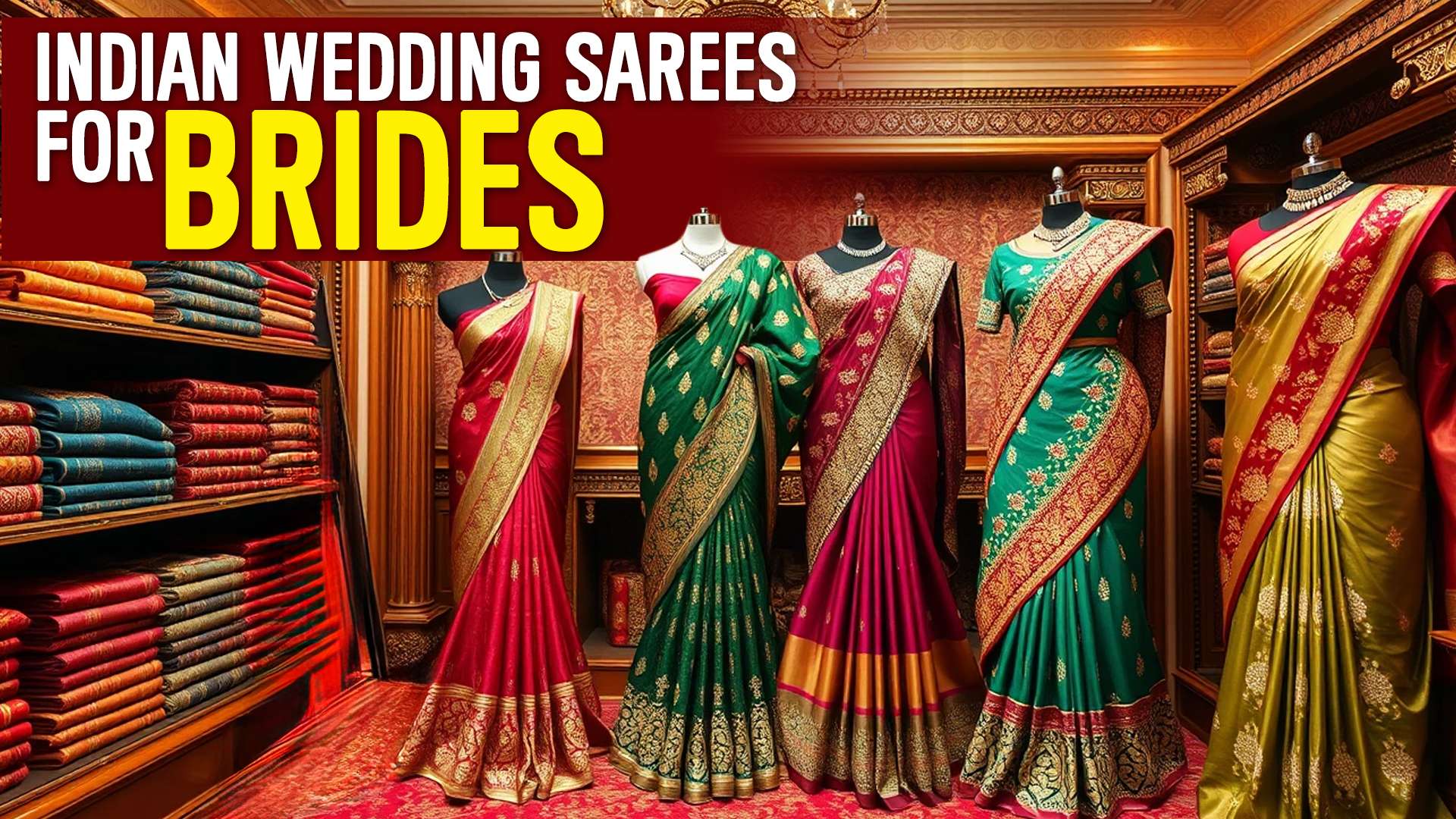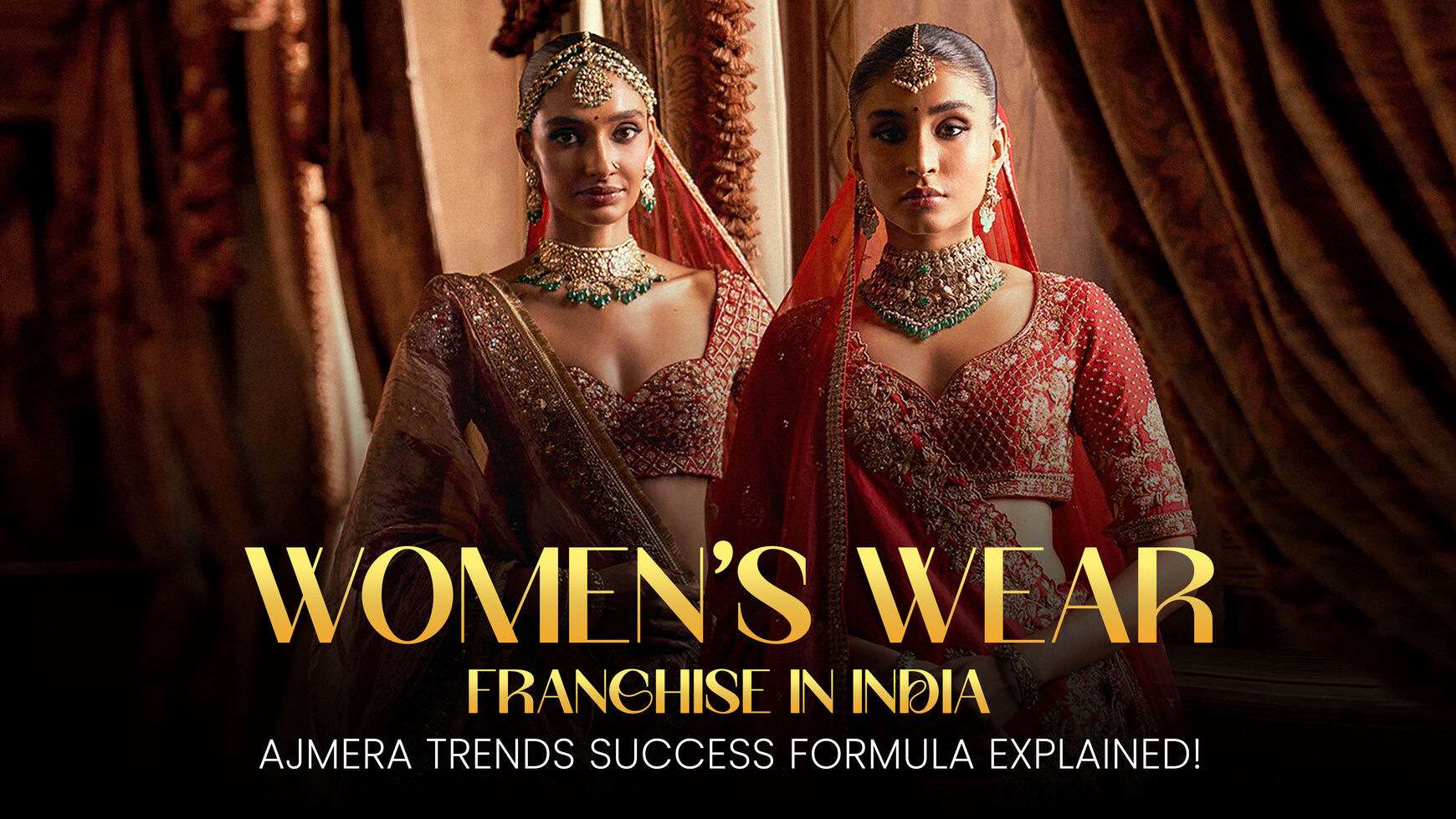Indian Wedding Sarees for Brides

Share Blog:
Importance of Saree in Indian Weddings
In the vibrant landscape of Indian weddings the saree stands as more than a garment—it is a profound symbol of cultural heritage,family traditions and the elegance of the bride, every tuft, every weave, every intricate design tells a story that goes beyond the clothes.
The mesmerizing beauty of Indian wedding sarees transcends just the fabric and design. It captures the profound message of cultural heritage, elegance of women and timeless beauty, when a bride dresses in a saree it transforms her into a living canvas of artistic expression with each thread meticulously woven the story of tradition, family pride and personal identity.
The unrivaled charm of the saree lies in its ability to emphasize the feminine silhouette in a fluid veil. It creates an ethereal movement and elegance that no other garment can replicate. This is unlike lehenga, which can often feel structured and limited. The saree provides a close connection as It celebrates the wearer's body.
This is because each region of India contributes to its own unique beauty. From the shiny Banarasi silk from north to magnificent kanjivaram silk sarees that reflect the rich temple traditions of southern India. The wedding saree is therefore a profound and personal choice.

Girls tend to prefer sarees over overalls because they represent the bond with mother, grandmother and father's lineage. And many brides choose to wear family heirlooms that carry memories and blessings from generation to generation.
The art of saree weaving is a ritual experience. It symbolizes the bride's transformation and her readiness to embrace a new chapter in life with every fold and pleat carefully arranged to express her journey, dreams, cultural roots, and more, unrivaled in dressing of a saree.
There are a variety of both traditional and modern styles that can be concealed. It allows the bride to express her personality while maintaining a deep respect for cultural traditions,luxurious decoration whether it is the exquisite saree work, delicate embroidery, or hand weaving, transforms a saree from a simple garment to a mesmerizing attire
Let it be a work of art that tells a story of craftsmanship, heritage and beauty perfected over the centuries. Basically when the bride chooses a saree, she didn't just choose a wedding dress. She embraces a living, breathing tradition that celebrates the femininity, resilience, and timeless beauty of Indian cultural expressions.
Regional Wedding Sarees Priorities:
North India: Banarasi Silk
The Wealth of Banarasi silk sarees are the highest , especially in Uttar Pradesh. Outstanding with gold and silver woven fabric these luxurious silk sarees are the pinnacle of a bride's beauty. Brides in Delhi, Punjab and Uttar Pradesh often opt for royal saris, which are a symbol of wealth, and prosperity
South India: Kanjivararam Silk
In southern states like Tamil Nadu and Karnataka, Kanjeevaram saree is an undisputed wedding dress. It is woven from pure mulberry silk and decorated with intricate gold zari work. These sarees represent the pinnacle of craftsmanship.Their bright colors and heavy border designs make them a valuable asset for generations to come.
West India- Baluchari Silk
-
West Bengal: Bengali brides often opt for beautiful sarees,Tant sarees are famous for their light cotton fabrics with intricately woven patterns, and Baluchari sarees with detailed mythological scenes show the artistic heritage of the region
-
Gujarat and Rajasthan: Bandhani and Gharchola Grandeur Bandhani sarees with tie-dye techniques and ghar chola sarees with checkered patterns and red bases are wedding favorites in these western states. These sarees reflect the colorful and vibrant culture of the region.

For Franchisee Inquiry, Call: +9163521 77288
Why is the saree so important in Indian weddings?
Cultural symbols- The saree represents more than just fashion. Because it is a story about cultural identity. Each saree style has a story from generation to generation. Regional history and family traditions for the bride wearing a striking saree is associated with her roots and heritage.
Beauty and spiritual significance- Draping a saree is considered a form of art. A symbol of elegance, dignity and femininity which changes the appearance of women in many Indian traditions, the wedding saree is believed to bring good luck and prosperity to the newlyweds
Explore India's diverse saree traditions
1. Banarasi Saree fabric -
Place of Origin: Varanasi, Uttar Pradesh
-
Features : Luxurious silk with intricate gold and silver brocade work
-
Characteristice: Heavy, luxurious, suitable for large weddings.
2. Kanjiivaram Saree
Place of Origin: Kancheepuram, Tamil Nadu
-
Features: Pure Mulberry Silk Gold, although it really works.
-
Characteristics: Bright colors, thick edges, distinctive shape.
3. Paithani Saree
Origin: Maharashtra -
-
Speciality: Hand-woven silk with peacock and lotus patterns.
-
Characteristics: Outstanding color combination, pure silk, decorated with gold.
4.Chanderi Saree
Product Origin: Madhya Pradesh
-
Features: Lightweight silk and cotton blend
-
Characteristics: Delicate design, translucent surface ,suitable for intimate wedding ceremonies
Ajmera Trend: The Ultimate Wedding Saree Destination
Why Trend Ajmera?
Ajmera Trends has emerged as the leading destination for wedding saree collections. They provide an unparalleled shopping experience for brides looking for perfection. Here's why:
-
Extensive Collection: From traditional banarasi sarees to contemporary eclectic designs, Ajmera Trends curates sarees from across India.
-
Quality Assurance: Every saree undergoes strict quality checks. Therefore, you can be assured of authenticity and craftsmanship.
-
Personal Consultation: Expert stylists help brides choose the right saree for their body shape, skin tone and wedding theme.
-
Preservation Service: Special packaging and preservation techniques preserve the quality of the saree for generations.
Conclusion:
A wedding saree is a beautiful blend of art, tradition and self-expression. A canvas that captures the essence of India's cultural diversity. Clothing that transforms a woman's appearance while honoring centuries-old traditions because brides are still embracing traditional, contemporary styles. The wedding saree is therefore a symbol of love, heritage and timeless elegance

For Wholsale Inquiry, Call: +916358907210
Also read: Why is Clothing Franchise Business Popular In India.
FAQs:
Question 1: What type of saree is best for Indian weddings?
A). The best wedding saree depends on regional traditions and personal preferences. Banarasi silk sarees are popular in northern India. While Kanjeevaram sarees are popular in South India. Each region has its own unique style. Factors such as fabric, function, color and personal comfort play an important role in the choice.
Q2: How much does a wedding saree cost?
A). Wedding saree prices range from ₹5,000 to ₹5,00,000 or more. Factors that affect the price include: Textile quality (silk, cotton, blended) Handicrafts (hand-woven, machine-made) Decorative work (joint work, embroidery) designer brands and region of origin
Question 3: How do I choose the right wedding saree for my body type?
A). Consider these tips:
-
Small frames: Light and soft fabric with subtle edge work.
-
Tall and Slim: Bold, heavy-duty design with contrasting borders.
-
Plus size brides: solid colors, vertical stripes, and lightweight fabrics.
Consult a professional stylist for personal advice.
Question 4: Why are sarees important in Indian weddings?
A). Sarees have deep cultural significance: It is a symbol of tradition and heritage. Represents the family lineage exhibiting regional handicrafts. It is considered an auspicious time and brings good fortune. It reflects the cultural identity of the bride.
Question 5: How many types of wedding sarees are there in India?
A). Some important types of wedding sarees are:
-
Banarasi Silk Saree
-
Kanjivaram saree
-
Paithani Saree
-
Chanderi Saree
-
Tant Saree
-
Bandhani saree
-
Kasavu sarees from Kerala
-
Patola Saree from Gujarat

For Franchisee Enquiry, Call: +9163521 77288
Also Read...
Who Are the Best Wholesale Clothing Manufacturers in India?
Franchise in Mumbai with Small Investment
How to Get Branded Products Wholesale in India ?
Franchise Business for Sale in India
How Much Would It Cost Me To Make My Textile Brand?
Which Textile Market Has Good Quality Fabric and Fashion in Surat?





